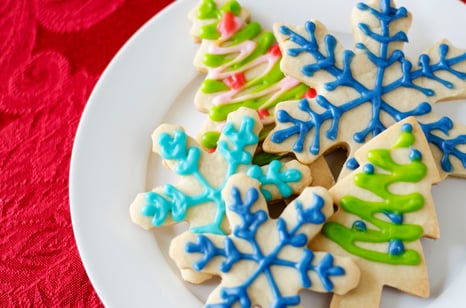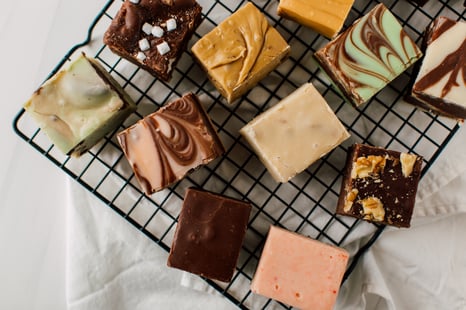Blog
3 Key e-Learning Design Steps From Pixar's Design Story
Some of us will inevitably face the annual Holiday Cookie Exchange. Some of us will anticipate it with delight; others with fear and trepidation. ...


e-Learning Lessons From the Holiday Cookie Exchange
By Ethan Edwards | December 14, 2021 | Custom Learning | 0 Comments
Some of us will inevitably face the annual Holiday Cookie Exchange. Some of us will anticipate it with delight; others with fear and trepidation. Sadly, that statement might equally apply to how students approach e-learning. In the festive spirit of the holidays, join me as I sample some of everyone’s favorite holiday treats, and attempt to extract some lessons we might use to create some absolutely scrummy (with all due respect to Mary Berry!) e-learning offerings.
Access this full e-book in the 2021 Holiday e-Book Bundle >>
Gingerbread Men

What could be more enticing than a plateful of tasty gingerbread men? They evoke tradition and their straightforward simplicity creates an automatic nostalgia for childhood, tradition, and predictable uniformity. The happy human forms should create something that we identify with immediately. But really? Only gingerbread MEN? Might not there by a gingerbread woman, child, or even a dog or tree?
Thinking of this, e-learning designers might think about who populates their e-learning lesson. Most organizations are continually challenged to address a highly diverse learner population. When learning examples are consistently drawn from a narrow or “typical” demographic, they can unintentionally distance the audience from connecting with the target content and performance outcomes.
Scenarios, stories, and characters can do wonders to draw learners into an interaction. But it is essential to craft those characters and profiles to be representative of your audience, your organization, and your community.
Sugar Cookies

Nothing beats a really good sugar cookie. Especially frosted sugar cookies. The colorful icing can add a visual enhancement to the pleasant taste, bringing meaning to the experience, sparking emotions related to familiar shapes, encouraging activation of memories, and elevating delight. But cookie decorating can be tricky. Too little leaves a lackluster, disappointing snack. Too much icing and embellishment may disguise and overpower the cookie underneath.
So it is, too often, with media and e-learning. We correctly accept that pictures and sounds may enhance the presentation of information. But designers often seem to apply the wrong amount. Media that is used timidly and is unrelated to the actual performance objectives can be worse than none at all, as it only highlights that the designer was unskilled or unable to command the available resources effectively in support of the subject matter.
But the reverse is more commonly the problem with e-learning. Modules are “decorated” in ways that neither complement the content nor elevate the learning experience, but merely dominate the experience in a way that distracts rather than focuses the learner’s attention. The media becomes an end in itself without regard to whether it actually improves the learner experience.
Fudge

Fudge is delicious, of course. Whether dressed up with nuts and special flavors or in its basic form, the rich smooth chocolate melts in one’s mouth, providing a sweet contrast to the crumb and doughiness of traditional cookies. Sometimes, this point doesn’t matter, but in spite of its appeal, we should remember, though, that fudge is not a cookie. Did the cook not understand the event was a cookie exchange?
Sometimes, e-learning presents a solution that simply doesn’t match the problem. Web-based elements might be combined into some sort of presentation that integrates video, avatar characters, or other gaming elements that, while appealing, fail to add up to instructional interactivity that might produce performance change.
Creating an experience that the learner finds appealing has value, but it rarely is enough to create a learning experience. The essential characteristics of Context, Challenge, Activity, and Feedback need to be present, even as we strive for elevated learning models. Games are successful not simply because they might be “fun” on the surface, but because they combine risk, challenge, context, and goal-driven action in a compelling way.
Read More
We still have guests bringing holiday wreaths, Russian tea cakes, store-bought Danish butter cookies, fruitcake, springerle, the "Nailed it!" cookie, peanut butter blossoms, chocolate chip cookies, candy cane cookies, latkes, and rum balls!
Access Your e-Learning Design Holiday e-Book Bundle Now >>
-
e-Learning Lessons from the Holiday Cookie Exchange
-
Avoiding Ugly e-Learning: Lessons from Holiday Sweaters

About the Author: Ethan Edwards
Ethan Edwards draws from more than 30 years of industry experience as an elearning instructional designer and developer. He is responsible for the delivery of the internal and external training and communications that reflect Allen Interactions’ unique perspective on creating Meaningful, Memorable, and Motivational learning solutions backed by the best instructional design and latest technologies.
Comments
Would you like to leave a comment?
Related Blog Posts

By: Ethan Edwards | Jan, 2016
Category: Custom Learning, Strategic Consulting

Blog
What Makes e-Learning Work?
Some of us will inevitably face the annual Holiday Cookie Exchange. Some of us will anticipate it with delight; others with fear and trepidation. ...
By: Ethan Edwards | Aug, 2016
Category: Custom Learning, Strategic Consulting

Blog
Avoiding Ugly e-Learning: Lessons From Holiday Sweaters
Some of us will inevitably face the annual Holiday Cookie Exchange. Some of us will anticipate it with delight; others with fear and trepidation. ...
By: Ethan Edwards | Dec, 2015
Category: Custom Learning


